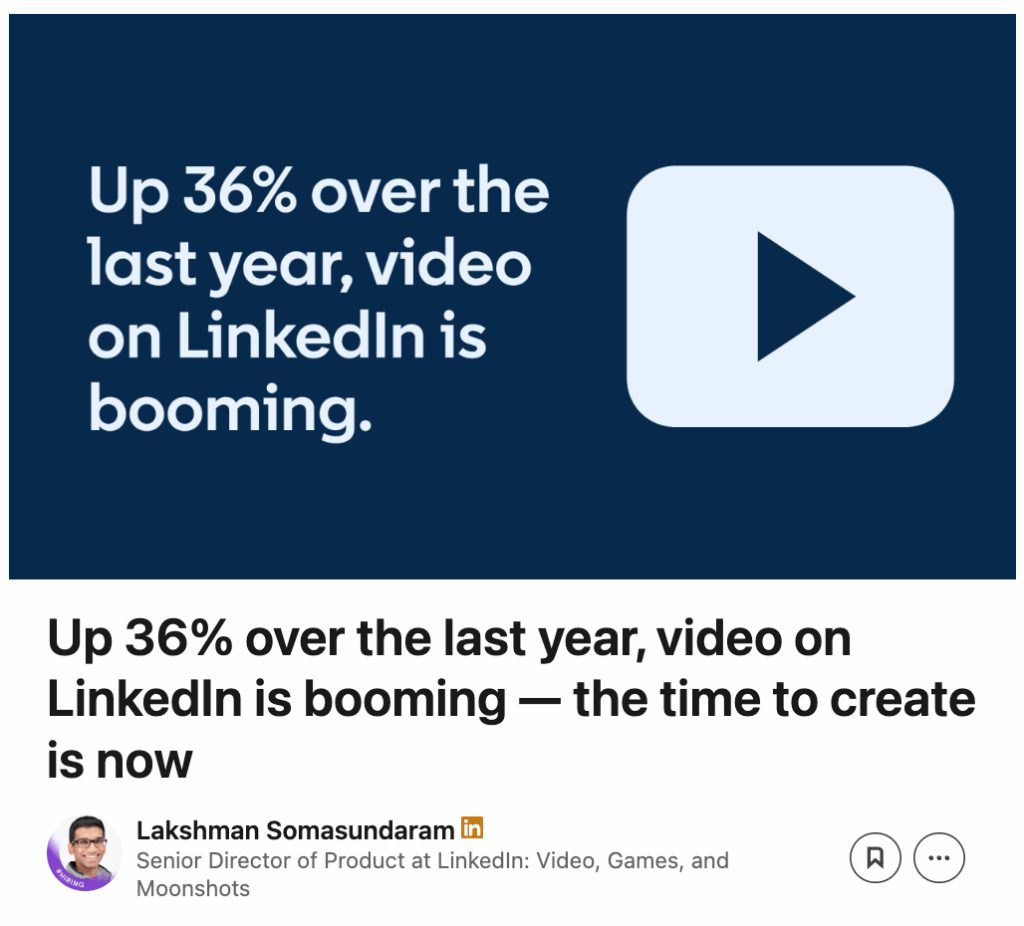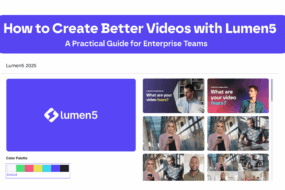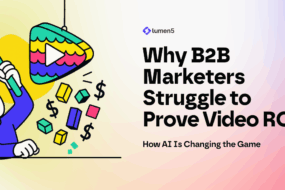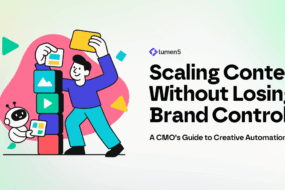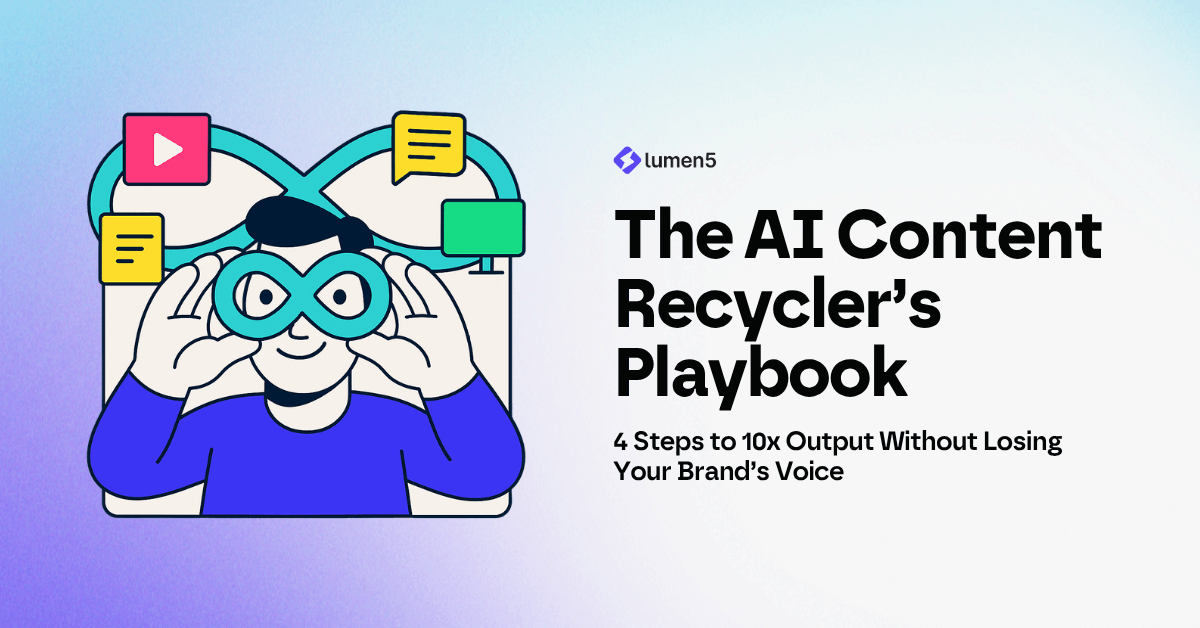
- The Content Overload Crisis
- 1) Why Repurposing Is the New Creation (and the CMO Math Behind It)
- 2) What Is AI Content Repurposing (and How It Actually Works for Enterprise Teams)
- 3) The 4-Step AI Repurposing Workflow (Identify → Transform → Optimize → Distribute)
- 4) Brand Governance, Risk, and Human Oversight (Scale Without Losing Control)
- 5) Proving ROI: The Metrics That Matter (and a Simple Model You Can Steal)
- 6) Where This Is Going Next: Adaptive, Video-First, Executive-Led Content Systems
- FAQ
- A Challenge to the Leadership Bench
The Content Overload Crisis
On a Tuesday afternoon, a CMO opened her team’s content drive and saw a graveyard: seventeen recorded webinars, three podcast seasons, six gated ebooks, and more than a hundred blog posts—mostly dormant. Not bad content. Just under-used content. She didn’t need another net-new campaign. She needed a way to activate what she already had, fast, without creating brand drift or burning out the team.
That moment is playing out across enterprise marketing. Budgets have flatlined at 7.7% of company revenue for 2025, which means leaders must squeeze more from the same resources and prove impact with fewer bets. The mandate is clear: do more, prove more, spend the same. That is not a creativity problem. That is an efficiency problem. The teams who are winning aren’t producing more; they’re transforming more, then distributing with ruthless precision. (Gartner press release).
AI content repurposing
Using machine intelligence to identify high-leverage assets, extract what’s timeless, and adapt it into channel-ready formats—from long-form to short video, from webinar transcript to LinkedIn clips, from podcast episode to newsletter and carousel—at a pace humans alone can’t match. Crucially, AI does not replace the point of view. It clears the runway so your subject-matter experts and creatives can sharpen the message and protect the brand.
If you’re skeptical about SEO impact, you’re asking the right question. Search quality bars are rising and Google is explicit: AI is fine when the output is helpful, reliable, people-first, and not scaled to manipulate rankings. Abuse—like low-value scaled content or site reputation abuse—is in the crosshairs. Translation: repurpose for users, not bots, and keep humans in the loop. (Google guidance on using gen-AI content, people-first content guide, spam policies overview).
This playbook shows how to build an AI-assisted repurposing system that increases output 5–10x while tightening brand control. You’ll get a practical 4-step workflow, governance safeguards, and an ROI model you can take to your CFO. You already have the raw material. Let’s unlock it.
1) Why Repurposing Is the New Creation (and the CMO Math Behind It)
For more on content efficiency, explore Content Velocity and the Modern Marketing Team.
If you run a large marketing org, you don’t have a content shortage. You have an attention and distribution problem. Budgets are not expanding to meet channel complexity. They’re steady. Gartner’s 2025 CMO Spend Survey shows budgets at 7.7% of revenue, consistent with 2024 and below pre-pandemic norms. With that constraint, productivity—not net-new volume—becomes your operating principle. (Gartner press release, Marketing Brew summary).
Here’s the hidden tax: content under-utilization. Forrester surfaced this problem years ago, estimating that 60–70% of B2B content goes unused. Even if your number is lower, the directional truth holds: most assets never get a second life. That is not a reason to create less; it is a reason to architect for reuse from day one and to mine the archive with a system that surfaces evergreen insights, not just formats. (Forrester blog referencing the stat).
Distribution dynamics amplify the case for repurposing into tighter, audience-matched cuts. Video is now the default language of business audiences, with viewers quick to bounce if value isn’t delivered fast. Wistia’s State of Video 2025 highlights rising expectations for short-form quality, expanding in-house production, and persistent pressure to hook early. That is exactly where repurposed micro-cuts earn attention. (Wistia report hub, Wistia stats article).
Platform behaviour matters too. On LinkedIn, video keeps climbing, with multiple industry and platform-adjacent reports pointing to ~36% YoY increases in watch time and stronger sharing for video posts. Treat your executives as channels; a visible leadership bench expands distribution without paid lift. (TechCrunch).
2) What Is AI Content Repurposing (and How It Actually Works for Enterprise Teams)
AI content repurposing uses machine learning to identify high-value moments in existing assets—blogs, webinars, podcasts—then summarize, script, and re-format them into new, channel-specific deliverables. Humans review for accuracy, tone, and brand before publishing.
At the system level, think “Input → AI Transformation → Output.” Inputs are long-form assets and raw transcripts. AI classifies themes, extracts highlights, drafts scripts or copy, proposes titles and hooks, and outputs variants such as vertical video cuts, LinkedIn carousels, email summaries, and blog refreshes. Humans verify facts, polish tone, and enforce brand standards.
Two truths keep your SEO and brand team comfortable:
- People-first quality is mandatory. Google’s guidance is explicit: you can use AI if content is helpful, reliable, and created for people. Teams get tripped up when they pursue scaled content purely for rankings. Anchor in E-E-A-T signals, cite primary sources, and add firsthand experience. (People-first content guide, Using gen-AI content).
- Reputation risks are real. Google updated spam policies and enforcement around site reputation abuse, penalizing third-party content that exploits a host site’s authority. If you syndicate or use marketplaces, ensure editorial standards match yours. (Spam policies, Google blog on March 2024 update).
Human-in-the-loop (HITL) checks:
- AI proposes; editors decide.
- All stats and claims are source-backed and linked.
- Brand templates for motion graphics, captions, lower thirds, and end-cards.
- Governance queue for sensitive assets (executive quotes, regulated claims) routed to legal and brand.
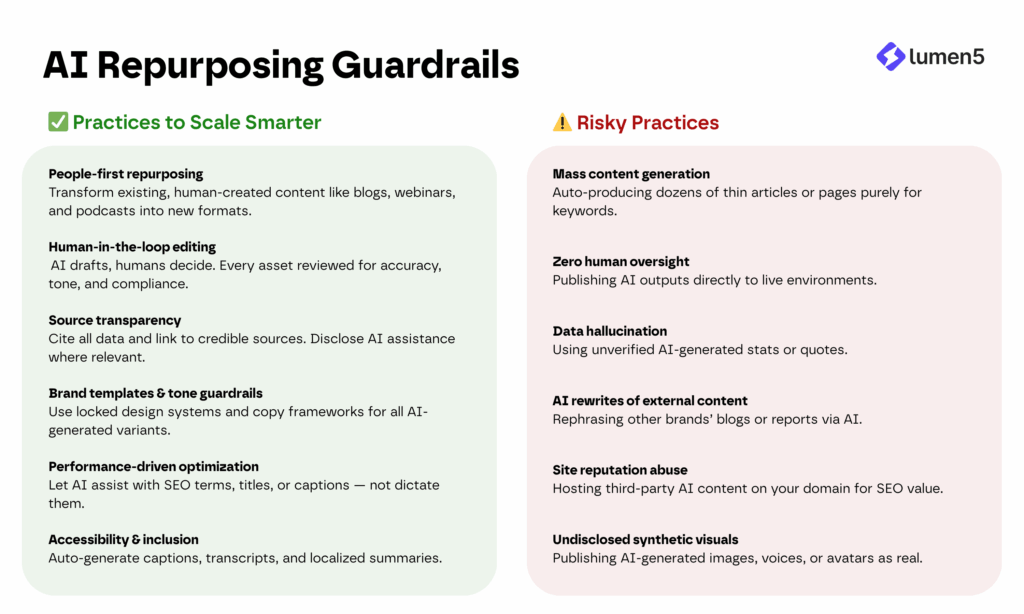
Tactical example:
Take a 45-minute webinar. AI identifies three standout moments, writes hook-first scripts, proposes five LinkedIn post angles, drafts a 1-minute CEO recap, and generates a newsletter blurb. Your editor validates facts, tunes tone, and applies brand visuals. In one afternoon, you’ve turned one asset into a multi-channel package without adding headcount.
Interested in learning more about which AI video creation tool has the fastest turnaround time? Read all about it here!
3) The 4-Step AI Repurposing Workflow (Identify → Transform → Optimize → Distribute)
| Step | AI’s Role | Human’s Role | Deliverable |
|---|---|---|---|
| 1. Identify | Score archives for evergreen potential, recency, search demand, and performance signals | Prioritize against campaigns and ICPs | Shortlist with impact scores |
| 2. Transform | Generate summaries, scripts, clip suggestions, captions, titles, carousels | Fact-check, tone-tune, restructure | Draft variants (video cuts, posts, emails) |
| 3. Optimize | Suggest schema, internal links, snippet-style answers, UTMs | Approve/override, enforce E-E-A-T | Search- and channel-ready assets |
| 4. Distribute | Auto-schedule variants, enforce naming and metadata | Final QA, localization | Published package + analytics plan |
Webinar → Omnichannel in 72 Hours
A software company hosts a 45-minute product webinar. Using this workflow, AI produces: a 90-second vertical highlight reel; three 20–30 second LinkedIn cuts with on-screen captions; a text recap for the blog; a sales one-pager; and an email digest. Humans tighten the narrative, verify claims, and apply brand templates.
Why this works now:
- Video is default behavior. Wistia’s 2025 data underscores rising expectations and the need to “get to value” quickly; repurposing enables tighter cuts and better hooks. (Wistia report hub).
- LinkedIn is the B2B megaphone. Watch time has increased significantly and platform updates are doubling down on video, improving discoverability and analytics. Repurposed clips travel farther with the same budget. (Axios, Social Media Today).
SEO guardrails built in:
- Blog refreshes include FAQ schema and short, direct answers for PAA and AI Overviews.
- Every claim links to a primary or reputable secondary source.
- Internal links point to your pillar page and supporting cluster pages.
- You avoid thin pages by adding new context or format utility, aligning with Google’s guidance. (People-first content guide).
What to measure from day one:
- Asset Reuse Rate: % of assets that get two or more formats within 14 days.
- Cost per Variant: Total production cost divided by outputs.
- Time to First Variant: Days from source asset to first publish.
- Channel Lift: Relative engagement vs. a rolling 90-day baseline.
🕒 Before AI Repurposing
Workflow: Manual, linear, and slow.
| Stage | Activity | Time Spent | Output |
|---|---|---|---|
| Day 1–2 | Record and edit webinar (45 min → 30 min final) | 8–10 hrs | 1 webinar replay |
| Day 3–4 | Write blog recap manually | 6–8 hrs | 1 long-form article |
| Day 5 | Create static promo graphics and captions | 4 hrs | 2–3 social posts |
| Total Time: ~18–22 hours | Total Outputs: 3–4 assets | Distribution: Limited to website + one LinkedIn post |
Result: Long turnaround, low reach, minimal reuse. Most of the content’s value stays locked inside the video file.
⚡ After AI Repurposing
Workflow: AI-assisted, parallel, and scalable.
| Stage | Activity | Time Spent | Output |
|---|---|---|---|
| Day 1 | Upload transcript → AI identifies highlight moments | 1 hr | 6–8 timestamped clip candidates |
| Day 1–2 | AI drafts scripts, summaries, and titles | 2 hrs | 1 blog recap + 3 LinkedIn post drafts |
| Day 2 | AI generates captioned clips and visuals (Lumen5 templates) | 3 hrs | 3–5 short videos |
| Day 3 | Human edits, tone reviews, and brand check | 2–3 hrs | Final approved assets |
| Day 4 | Auto-schedule and publish across channels | <1 hr | Full omnichannel rollout |
Total Time: ~8 hrs
Total Outputs: 10+ assets
Distribution: Blog, LinkedIn, newsletter, YouTube, internal enablement
Pro tip: Pair this workflow with Lumen5 to go blog → video in minutes, then spin out short clips sized for LinkedIn and email embeds. As Wistia’s data shows, short, well-hooked cuts increase your odds of earning the next click. (Wistia stats).
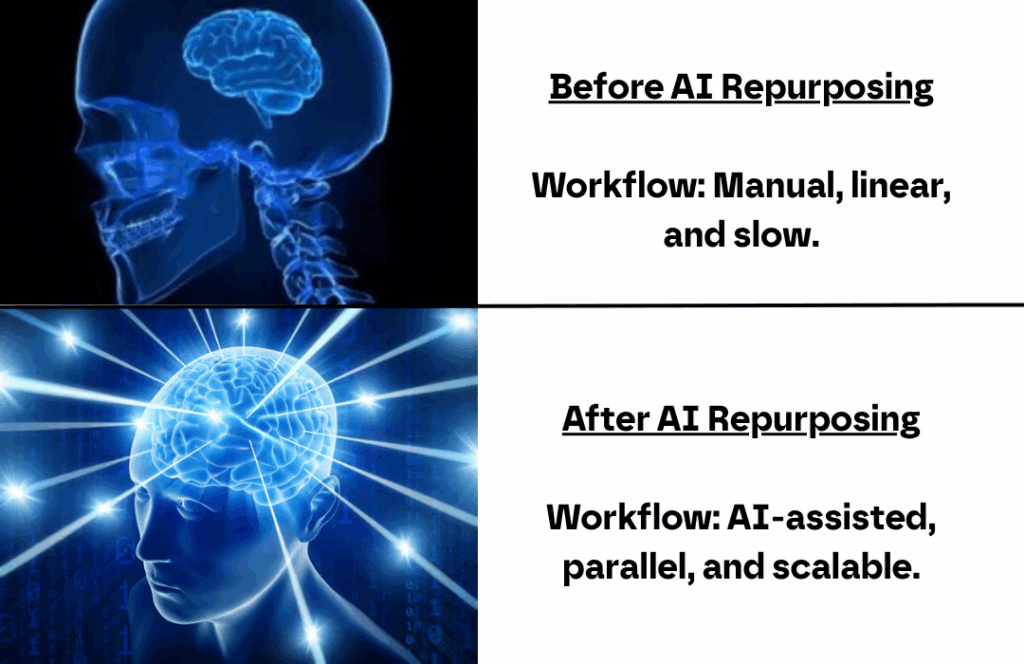
4) Brand Governance, Risk, and Human Oversight (Scale Without Losing Control)
Automation without governance is faster chaos. The mission is to scale output while preserving brand integrity—tone, visual identity, claims discipline, and compliance.
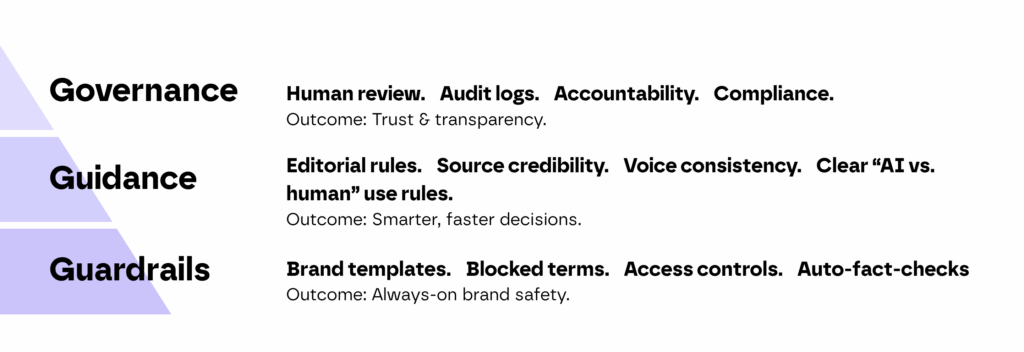
The three layers to implement while scaling output:
- Guardrails (Always-on controls)
- Brand kits and templates for lower thirds, end cards, carousels, caption styles.
- Terminology blocklists and claim substantiation rules in prompts and review checklists.
- Access control for sensitive topics, with legal routing where required.
- Guidance (How to decide)
- When to automate vs. humanize: automate summaries, clipping, and formats; humanize POV, prioritization, and story arcs.
- A source credibility ladder: primary research first, then reputable industry studies, then high-quality media coverage.
- Executive voice guidelines for on-camera content.
- Governance (Accountability and audits)
- A pre-publish checklist aligned to people-first content, originality, citations, E-E-A-T signals.
- Monthly audits for thin/duplicative content to consolidate or retire.
- Reputation safeguards if you syndicate: partner standards must match yours to avoid site reputation abuse risk. (Spam policies overview).
Why this matters for search and trust: Google continues to reduce low-quality, unoriginal, and scaled content in search. Recent enforcement and policy updates specifically target mass-produced content and “parasite SEO.” Your best protection is a process that documents human oversight and showcases your unique experience—what your experts learned. (Google March 2024 update, The Verge coverage).
Practical checklist for your workflow tool:
✅ Every claim cited with a link.
✅ Author and reviewer listed (HITL proof).
✅ Schema included (FAQ/HowTo/Article, as relevant).
✅ Template applied (visual + copy).
✅ Compliance tags for regulated markets.
✅ Distribution plan with UTMs and canonical strategy.
Tools like Lumen5 support brand kits, colour locking, and on-screen text templates so automated assets stay visually and tonally consistent.
5) Proving ROI: The Metrics That Matter (and a Simple Model You Can Steal)
A CFO-friendly repurposing program stands on time saved, cost per variant, and incremental reach/engagement—not vanity output. Start with a baseline month of “business-as-usual,” then shift a pilot product line into AI-assisted repurposing for four to eight weeks.
Core KPIs
- Asset Reuse Rate: % of source assets that spawn 3+ variants within 14 days.
- Time Saved per Variant: Hours saved vs. manual process (editorial + design + video).
- Cost per Variant: Total program cost / number of outputs. Target a 40–70% reduction after ramp.
- Engagement Lift: Relative change vs. a 90-day baseline by channel.
- Sales-Assist Signals: Content touches in won deals; consumption by buying committees.
Define Value as pipeline influenced, sales velocity impact, or paid media savings when repurposed organic performs work you would otherwise fund with spend.
Manual vs. AI-assisted (example)
- Manual: 1 webinar → 1 blog recap + 1 clip, 3–4 days, higher cost per variant.
- AI-assisted: 1 webinar → recap + FAQ + 3 clips + CEO TL;DR + newsletter + carousel, ~1–1.5 days, ~40–60% lower cost per variant after QA. These deltas align with productivity gains seen under stagnant budgets. (Gartner press release).
Evidence to reference in your exec deck
- Video expectations are higher; repurposed micro-cuts help you test hooks and keep attention. (Wistia report hub).
- LinkedIn’s video momentum strengthens the distribution case: watch time and views rising with new discovery features. (Axios, Social Media Today benchmarks).
Measurement cadence
- Weekly: asset reuse rate, time saved per variant, published variants by channel.
- Monthly: engagement lift vs. baseline; % of variants hitting target watch/scroll depth; pipeline-influenced touches.
- Quarterly: ROI roll-up with conservative attribution, content shelf-life analysis, and a retire/refresh plan.
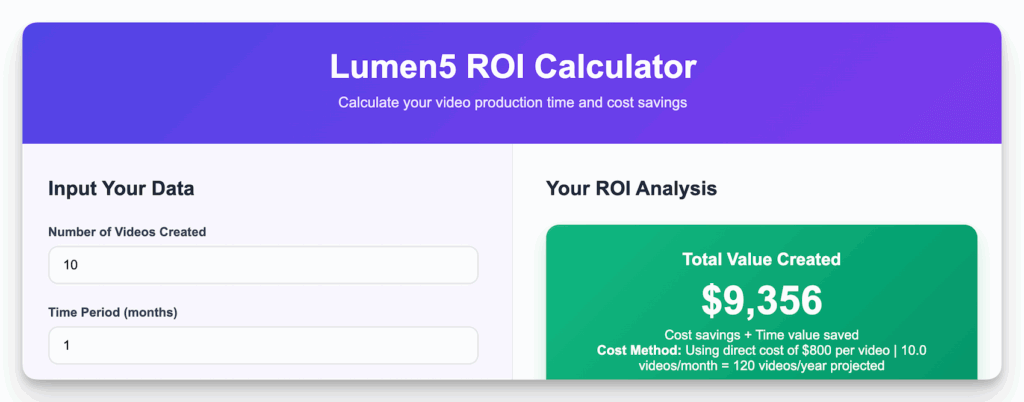
If you want to model the impact, plug your own numbers into a simple sheet or use the Lumen5 Video ROI Calculator, then trial Lumen5 on a single webinar to compare manual vs. AI-assisted production on time and cost .
6) Where This Is Going Next: Adaptive, Video-First, Executive-Led Content Systems
We are moving from repurposing to orchestrating: systems that continuously sense what your audience cares about, tag your assets semantically, and generate variants on demand—studio quality when needed, social-native when speed matters.
Three shifts to watch
- AI orchestrators and semantic tagging.
Your archive becomes a structured knowledge base. AI models cluster topics, map questions across the buyer journey, and propose content paths. This is where answer visibility matters as much as classic rankings. With AI Overviews now part of the landscape, brands must design content that is citable and useful enough to appear in answers without risking thin or derivative output. Anchor in your own data, case studies, and expert POV. (Google I/O launch of AI Overviews, Search Engine Land rollout, Ahrefs explainer and timeline). - Executive video as distribution engine.
LinkedIn’s video push is accelerating. Treat your executives as channels: build short, high-value scripts distilled from long-form material and maintain a steady cadence. Platform updates, creator programs, and brand sponsorships are increasing uploads and views—another incentive to feed the machine with repurposed clips. (Reuters on LinkedIn’s video ad push). - Search expectations keep tightening.
Google’s policy and enforcement cycles continue to target low-value scaled output and site reputation abuse. Your advantage is experience-led content with clear authorship, citations, and schema that help machines understand and surface your work across classic results and AI summaries. (People-first content guide, spam policies).
How to future-proof now
- Own your POV. Ship original benchmarks, case studies, and frameworks. Repurpose from those; do not echo the echo chamber.
- Instrument for answers. Add FAQ blocks and concise definitions to high-opportunity pages; use schema to increase eligibility for AI experiences. (Google AI features in Search docs).
- Invest in executive readiness. Build a video kit for leaders with a repeatable script pattern (hook → lesson → CTA).
- Create a “content control tower.” A weekly ops stand-up that scans performance, updates the backlog of repurposing opportunities, and green-lights fast turns.
Platforms like Lumen5 are evolving from creation tools into orchestration hubs—connecting inputs, templates, and distribution so teams can scale without sacrificing brand control.
FAQ
How can AI repurpose old content safely?
Use a human-in-the-loop workflow, enforce brand templates, and cite primary sources. Align with Google’s people-first content guidance and spam policies to avoid scaled, low-value output. (People-first, Spam policies).
Does AI-generated repurposed content hurt SEO?
Not if it’s helpful, original, and experience-led. Problems arise when content is mass-produced to target queries without adding value. (Using gen-AI content responsibly).
What tools can automate repurposing?
Look for solutions that convert text to branded video, generate clips with captions, and export channel-sized variants. Lumen5 is designed for exactly this use case with brand kits and templates.
How can I measure the ROI of AI repurposing?
Track asset reuse rate, time saved per variant, cost per variant, engagement lift, and sales-assist signals. Use the ROI formula and compare manual vs. AI-assisted sprints.
A Challenge to the Leadership Bench
A veteran creative director once told me, “Every campaign has a second life. Most of us are just too busy making the next one to find it.” She is right. The brands separating from the pack aren’t posting more; they’re unlocking the second and third lives of what already resonates, through a system that respects strategy, governance, and time.
For the next 30 days:
- Pick three high-leverage assets (a webinar, a research post, a customer story).
- Run them through the 4-step workflow: identify → transform → optimize → distribute.
- Enforce the HITL rule: AI drafts, humans decide.
- Track reuse rate, time saved, and cost per variant.
- Share the before/after in your exec meeting.
You will feel the cultural shift immediately. Editors ask for insights, not assignments. Designers work from templates that amplify, not reinvent. Executives become distribution partners rather than bottlenecks. And the creative energy you were spending on rinse-and-repeat formats moves to the hard work—finding the angle only your brand can credibly own.
The search landscape will keep changing. AI Overviews will evolve. Algorithms will reset. What will not change is how humans respond to clarity, relevance, and craft. That is your moat. Let machines handle the repetitive edges so your people can protect the perspective.
Make that the litmus test for everything you ship this quarter. If your output increases and your point of view gets sharper, you’re on the right path. If either slips, slow down, tighten governance, and get back to the basics. Your best content is already in the building, time to let it work harder with a little help from AI and tools like Lumen5!


